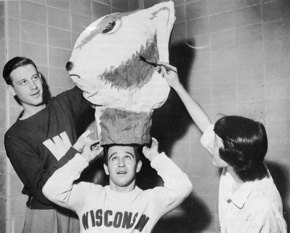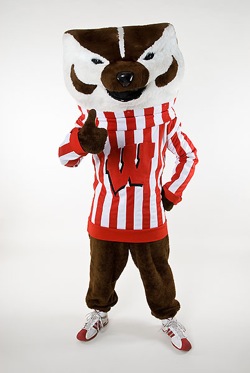Creator of Bucky dies, but legacy of mascot lives on
It would be easy to think that Bucky Badger always existed. That he always magically appeared at every single game, every single event. That we always knew “how to Bucky.”
But without William “Bill” Sachse, there would be no Bucky.
While the badger had been the University of Wisconsin–Madison’s mascot since the inception of intercollegiate football in 1889, it wasn’t until 1949 that Bucky was born, replacing the live and not-so-friendly badgers of the past.

William Sachse, left, helps Bill Sagal put on the first Bucky Badger head, while Carolyn Conrad applies some finishing touches.
Photo: UW Archives
“He was so anti-social. Once you dragged him out of the runaway (in the stadium), he’d immediately start burying into the turf on the field to hide,” Sachse said of the original mascot in a 1999 Wisconsin State Journal story. “That was the badgers’ disposition, and we couldn’t change that.”
Sachse got an idea while having dinner at the Memorial Union.
“I saw a display of papier mache African masks and I thought: Why not a papier mache head of a badger?” Sachse told the State Journal.
The kinder, gentler Bucky – full name Buckingham U. Badger – has since become a beloved and enduring symbol for the university.
On Sunday, May 20, Sachse died after a brief illness. The 85-year-old from Kohler, Wis., leaves behind an amazing legacy and one of the most iconic college mascots of all time.
Bucky had been once known by names like Benny, Buddy, Bernie, Bobby and Bouncy. A contest was created to officially name the badger – a contest Sachse would later admit was rigged.
“We knew we wanted the name Bucky, but the contest entries weren’t hitting the mark,” Sachse told the State Journal in 1999.
Now, it’s hard to imagine Bucky with any other name.
“I’ve been on campus 36 years,” says Paula Bonner, president and chief executive officer of the Wisconsin Alumni Association and a UW alum. “I’ve seen Bucky a million times and it never gets old.”

Bucky today: The tradition lives on.
Seven students share Bucky duties at more than 600 events a year. About 40 try annually.
“It’s very competitive,” says Josette Scheer, spirit squad director. “He’s the ultimate ambassador for the university.”
Stacy Bruner, 23, a UW senior, is in his third year of being Bucky and has attended more than 250 events. The Madison native grew up wanting to be Bucky ever since he was 8 years old and saw Bucky skate at a hockey game.
“I said, ‘Dad, I don’t want to play hockey anymore. I want to be Bucky,’” Bruner says.
The whole family was thrilled when his 8-year-old aspirations came true.
“It’s an honor and very big responsibility,” Bruner says. “When you’re in the suit, you are 100 percent representing the university.”
Football games can be exhausting with Bucky expected to do a pushup for every point scored.
“When you’re up there with 80,000 people counting your pushups, it’d be pretty hard not to do them all,” Bruner says of the adrenaline rush that comes during game time.
While people often associate Bucky with games, some of Bruner’s favorite events are for visits with children, including those staying at UW Hospital.
“We’re putting smiles on their faces even though they’ve been there for month at a time,” Bruner says. “It’s really rewarding.”
Sachse graduated from UW with a business degree in 1950. While at the university, he lettered three times as a varsity oarsman, was a member of the National “W” Club, the Bascom Hill Society and Delta Kappa Epsilon fraternity.
For many years, Sachse was a vice president of Robert W. Baird & Co. and managed its Sheboygan office. He was also a founding partner of Milwaukee-based Capital Investment Services of American until he retired.
Besides his wife Mary, he is survived by his son, William Sachse, Jr. of Whitefish Bay, Wis., his daughter, Anne Sachse of Fox Point, Wis., and his daughter-in-law, Susan Sachse of Scottsdale, Ariz.; three grandchildren, Taylor, Lisa, and Jackson Sachse of Scottsdale, Ariz.
Bucky has endured over the years, despite a suggestion in 1973 by assistant attorney general Howard Koop that Bucky be replaced by Henrietta Holstein, a loveable and productive cow. Koop argued that “kids love cows. A generation could grow up supporting the university and Henrietta Holstein.”
Henrietta became a footnote and Bucky has become an icon.
“We owe Bill a great deal of thanks and appreciation for what he got started,” Bonner says. “Bucky is part of our DNA. He just makes you smile. He’s one of the forces of good in the world.”
